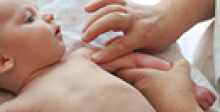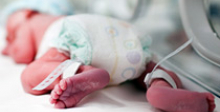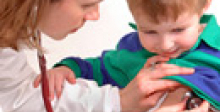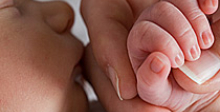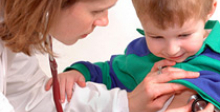Internal mini form
Contact Us Today
One aspect of the diagnostic process a parent will likely need to prepare a child for is the number of medical exams, evaluations and laboratory tests that can take place to determine whether or not a child has Cerebral Palsy. Though time waiting for a diagnosis is stressful, these tests and assessments allow a parent to come to terms with an eventual diagnosis, and begin early interventions.
What types of evaluations are used to diagnose Cerebral Palsy?
Unfortunately, no single test or screen will definitively confirm Cerebral Palsy. In severe cases, or under specific circumstances, a child may be diagnosed shortly after birth. In the majority of cases, however, medical practitioners will most likely observe, screen, and test the child over the first one to five years of development and growth. During this time, doctors are able to rule out conditions, including Cerebral Palsy.
If at all possible, it is suggested parents establish reproductive health prior to conception. Parents should become aware of risk factors that heighten the likelihood a child may develop birth defects, including Cerebral Palsy. During pregnancy, the expectant mother should immediately disclose to her doctor any exposure to risk factors and new health developments. The doctor will then attempt to properly treat, prevent, and prepare for contingencies.
After a baby is born, he or she is screened for health conditions. Screens are performed on newborns, according to state guidelines or when a doctor may have cause for concern. Each state has its own guidelines detailing the types of screens standard for every newborn child. Additional screens or tests may be ordered if the medical practitioner detects a cause for concern.
Screens are different than diagnostic tests. Screens are used to indicate a possible concern, whereas diagnostic tests are more extensive and conclusive. Infants, toddlers and children require numerous well-baby care visits in the months following birth and into school-aged years. A child is clinically monitored for growth, development, and health during this time, and parents are urged to share any concerns or noticeable differences they observe in the child. School representatives are also trained to assess age-appropriate development and growth.
If a child does not meet established growth standards, developmental milestones, or is having difficulty with mobility, a physician is likely to perform detailed examinations, order additional tests, or refer the child to other medical specialists. These steps are taken to rule out, or reveal, medical conditions. A compilation of test results may be required to formally diagnose Cerebral Palsy; proper identification of the condition can be a lengthy process.
Most will agree, however, that early diagnosis is beneficial. Doctors believe parents need time to bond with their child, and they, as medical professionals, need to observe the child over time. Doctors are also concerned with properly identifying conditions in order to avoid misdiagnosis.
On the other hand, unwarranted delay in diagnosis should be avoided, as well. Early diagnosis allows parents not only the peace-of-mind that comes with knowing the child’s condition, but also allows the opportunity for early intervention, which can optimize the child’s development. Government benefits, funding sources, lifetime benefits, and special education offerings can be pursued after a formal diagnosis is made.
Screens, tests and evaluations which may aid in the diagnosis of Cerebral Palsy include:
These screens, tests and evaluations are detailed below.
Establishing Reproductive Health
Planning a family, or learning that you’re about to start one, can be an exciting time. It is also a crucial time to begin providing for the safety of the child. Before pregnancy it is extremely valuable to consult a doctor. In the initial stages of pregnancy, a series of visits to the doctor are essential.
Many risk factors are known to increase the likelihood of a child developing Cerebral Palsy or other conditions. Awareness is the best way to reduce risk; it’s also a good idea to know what actions to take if exposure to risks does occur.
While risk factors are a significant concern during pregnancy, the threat of potential harm from exposure to those factors exists even prior to conception. Smoking, infections, exposure to toxins – everyday products, in some cases – prescription drugs, parental age, and blood type incompatibility are a few factors that can greatly impact the development of a child in the womb.
By visiting a doctor during family planning; assessing health status; and talking about past and current habits, risk factors can be identified.
Establishing reproductive health involves:
- Reproductive Health Analysis
- Preconception Health Check
- Blood Compatibility Testing
Assessing health factors and addressing any concerns will lay the ground work for a healthy pregnancy for mother and baby.
Screens for Cerebral Palsy
Screens are tests performed on all newborns to discover possible hidden complications in seemingly-healthy children. Tests, on the other hand, are ordered for specific infants and children, and are used to help make a diagnosis, either by confirming or ruling out possibilities.
Many serious conditions have no visible effects on newborns, and only appear as the child grows. The goal of screening is to catch potential issues before symptoms appear. For screening, a few drops of blood are taken from the newborn’s heel and tested. Usually, parents are contacted only if lab results reveal areas for further monitoring or testing.
Newborn screening is regulated by individual state governments; the type of screens a child receives will vary depending on which state he or she was born in. Details about the various screens required in any given state are available at the National Newborn Screening & Genetics Resource Center.
Newborn screens administered in all states include:
- PKU (phenylketonuria) – a condition in which the body can’t process a certain protein found in most foods, and results in cognitive impairment or brain damage
- Sickle cell disease – a blood disorder
- Hypothyroidism – a condition where the thyroid doesn’t produce enough hormones
- Galactosemia – a condition in which the body can’t process the sugar galactose found in milk
Other screens not automatically administered in all states include:
- Hearing impairments
- Organic acid metabolism disorders
- Fatty acid oxidations disorders
- Amino acid metabolism disorders
- Hemoglobinopathies (a group of blood disorders)
APGAR Score. One standard screen for most all newborns in the United States is the APGAR (activity, pulse, grimace, appearance, and respiration) score. The APGAR, a standard medical test used to gauge a newborn’s heart and respiratory health, is usually recorded at one minute after birth (to assess how the baby tolerated birth) and again at five minutes (to determine how well the baby is adapting after birth).
APGAR does not definitively identify Cerebral Palsy, but a low APGAR score can indicate areas for concern for many medical conditions, including Cerebral Palsy. Screens are not used to diagnose Cerebral Palsy, but can be used to determine whether further tests are necessary.
For more information, see APGAR Score.
Tests for Cerebral Palsy
Tests are used to determine or rule out various conditions. They are more extensive and conclusive than screens. Since there is no test for Cerebral Palsy, most tests performed on children who may have Cerebral Palsy are used to either rule out other possibilities or to determine the cause, location, extent and severity of impairment. Certain tests, such as determining the presence of reflexes, can be performed during an office visit. Other tests – those of a neurological nature, for example – often require referral to a medical specialist and specialized tests.
Imaging Tests
Neuroimaging tests are commonly used in diagnosis of Cerebral Palsy. Since impairment results from damage to the brain, neuroimaging – pictures of the brain by noninvasive techniques, essentially – allows doctors to see the actual injury. The scans, however, cannot predict the effect an injury will have on the child.
Sometimes children with an apparent injury will have no impairment, while other children with no obvious damage will develop Cerebral Palsy. Still, neuroimaging is a powerful and dependable tool in diagnosing Cerebral Palsy.
Three Types of Neuroimaging
Cranial ultrasound/ultrasonography uses sound waves to capture an image of the brain. The cranial ultrasound is painless and the least intrusive of the possible techniques, but does not produce the same quality of results as an MRI or a CT scan. Still, results can show abnormalities, cysts, and structures in the brain.
The cranial ultrasound can only be used on an infant before the cranial bones are fully formed or after a fully formed skull is surgically opened, as the sound waves cannot pass through bones. The cranial ultrasound is deemed valuable on infants from birth to age 18 months that have difficulty remaining still for the 30 minutes required to perform an MRI or CT scan.
The cranial ultrasound is commonly performed on premature babies where bleeding in the brain, such as intraventricular hemorrhage (IVH) or periventricular leukomalacia (PVL) is suspected. IVH and PVL are two of the four causes of brain damage that may lead to Cerebral Palsy. IVH commonly develops within the first week of birth, whereas PVL may take several weeks detect. In severe cases, a cranial ultrasound may be performed one week after deliver for IVH, and again at 4 and 8 weeks of delivery if PVL is suspected.
The cranial ultrasound may also be used to rule out other conditions such as infections in and around the brain (encephalitis or meningitis), evaluate large or increasing head size, or screen for a build-up of excess cerebrospinal fluid in the brain at birth (congenital hydocephalus).
MRI (magnetic resonance imaging) uses a combination of magnetic fields and radio waves to capture an image of the brain or spine. It is the preferred neuroimaging method and achieves the clearest results. The child needs to remain still for the length of the exam, which lasts around 30 to 45 minutes. It is also a very loud process which, although completely painless, can be extremely uncomfortable for children. Sedation may be necessary if this is difficult for the child. Two types of MRIs may be valuable in diagnosing Cerebral Palsy:
- MRI of the brain is thought to define brain structure and abnormality more accurately than CT Scans or ultrasound.
- MRI of the spinal cord is useful in detecting abnormalities of the spinal cord for children with leg spasticity, bowel complications, and improper bladder functioning. The condition may be related to Cerebral Palsy, or a co-mitigating factor.
Sedation has been used during MRIs to minimize infant movement as movement can prolong the examination and exposure. Sedation is not without risk to infants. Respiratory depression by apnea, hypoventilation, or hypoxemia is a common side effect of sedation. It is recommended that procedural sedation be administered by anesthesia department staff who are properly trained and credentialed NICU clinicians. Infants must be properly monitored for cardiac, respiratory, pulse, blood pressure and carbon dioxide measures prior and during the procedure. Staff members administer sedation, manage adverse reactions to sedation, and recover infants from sedation. It is recommended a sedation scoring tool be used to evaluate the level of sedation.
An alternative to sedation is to conduct the MRI during natural sleep patterns which usually follow feeding. In this scenario, an effort to reduce noise and light, while avoiding stimulation is recommended. The baby should be warm, swaddled and positioned to minimize movement. Although less risky, this option may require additional time and planning.
CT scan (computer temography scan, sometimes referred to as computerized axial tomography, or CAT scan) combines X-rays taken from numerous angles to provide cross-sectional views of a child’s brain. The results are better than cranial ultrasounds, but not as conclusive as MRIs. The test can take 30 minutes or more. Sedation may be necessary for children who find it difficult to remain still.
Researchers in Sweden have warned some in the medical community about the use of high doses of ionising radiation on developing brains. The study of 3,000 men who had scans before 18 months of age found the men developed learning difficulties. Similar studies, like one performed at the Karolinska Institute in Stockholm, questioned whether lower doses of radiation would decrease risk. Their study conducted on 3,094 men who received radiation as toddlers found a correlation between the intensity and learning problems. They concluded the higher the dose, the higher the likelihood an individual develops learning problems.
Both studies suggest new guidelines to ensure doctors do not use CT scans on young infants. CT scans use high levels of ionising radiation. If a doctor is considering this options, the parent of the child should ask the doctor about this risk.
EKG’s, EEG’s and EMG’s
Electroencephalography (EEG) and Electromyography (EMG) are similar tests that are performed to gain insight into how the nervous system is functioning. Both use special electrodes placed on the skin that can detect the electrical impulses created by the brain and the central nervous systems. Both tests produce line-tracings that show the “peaks and valleys” of the electricity generated.
Electroencephalography (EEG) is not used to detect Cerebral Palsy, but instead is used to diagnose seizure disorders. Epilepsy is a condition commonly associated Cerebral Palsy. An EEG is ordered when doctors find evidence of seizures. With an EEG, electrodes are attached to a child’s scalp to detect brain activity. The procedure is painless.
Electromyography (EMG) is used to detect nerve impulses relating to muscle activity. Nerves “fire” by sending electric impulses along their length. Before a muscle can flex, nerves need to stimulate the contraction. An EMG detects the nerve impulses sent to the muscles. Like an EEG, special electrodes are placed on the skin. EMGs are painless.
Nerve Conduction Studies (NCS) are used to detect damage in the nerves leading away from the central nervous system.
X-Radiation (X-Rays) uses electromagnetic energy to detect density of body tissue and transfers the image to film.
Laboratory Tests for Cerebral Palsy
Lab studies are performed when samples are taken and sent to the laboratory for analysis. The laboratory can be on or off-site. Blood work, urinalysis, and genetic testing are common examples of “lab work.” Like all tests, lab work can be used to identify or rule out conditions other than Cerebral Palsy. Common lab work uses blood or urine to discover a multitude of conditions.
Blood tests include many different tests that help in detecting hereditary and other conditions.
- Chemistry panels are routine tests performed on blood to gauge a person’s overall health. They are useful in analyzing major body organs.
- Plasma screens can detect various conditions that can appear as Cerebral Palsy, for instance, plasma ammonia.
- Chromosome analysis may detect hereditary conditions that are the cause of impairment.
- Creatine phosphokinase (CPK) isoenzymes tests can detect injury in the heart, brain, and skeletal muscles. The type and amount of CPK isoenzymes found indicate what is injured. High levels of CPK-3 are a sign of muscle injury, or stress, and may be a factor in diagnosing Cerebral Palsy
Urine tests are similar to blood tests in that there are many kinds of urine tests which can help to diagnose (or rule out) various conditions. Tandem mass spectrometry (MS/MS) is often used to examine the chemical contents of urine. High levels of amino acids, organic acids, or other molecules can identify various disorders. Early detection is crucial. These tests are often utilized in the newborn screening process.
Evaluations for Cerebral Palsy
As part of the diagnosis process, doctors will perform evaluations of the child to judge whether impairments exist and what those impairments are. They will also evaluate extent and location of impairment. A child’s growth is measured against medical industry standards to gauge developmental delay. Age and weight appropriate mobility is assessed. Parental input on observations, concerns, or risk exposure is encourage to be shared with the medical practitioners.
If Cerebral Palsy is suspected, associated conditions like seizure activity, hearing, speech, sight, and learning are also explored. These evaluations may help in the diagnosis of Cerebral Palsy, as well as determine the types of tests to be performed next.
Evaluations include:
- Mobility and orthopedic evaluation – orthopedic evaluation to ascertain reflexes, motor development, muscle tone, balance, posture, fine motor skills, and gross motor skills
- Gait analysis – usually performed as part of orthopedic evaluation for children to ascertain difficulties with walking
- Speech and language evaluation – oral motor analysis
- Hearing tests – auditory analysis
- Vision evaluation – ophthalmic analysis
- Feeding and digestion – gastroenterologic evaluation
- Cognitive analysis – neurologic evaluation to determine intellectual and cognitive impairment
- Rehabilitative evaluations – to ascertain therapy and assistive technology needs
RESOURCES:
Tests and Screens
For other sources with general information on tests and screens for cerebral palsy, MyChild™ recommends the following:
Centers for Disease Control and Prevention CDC
March of Dimes
Other Sites



